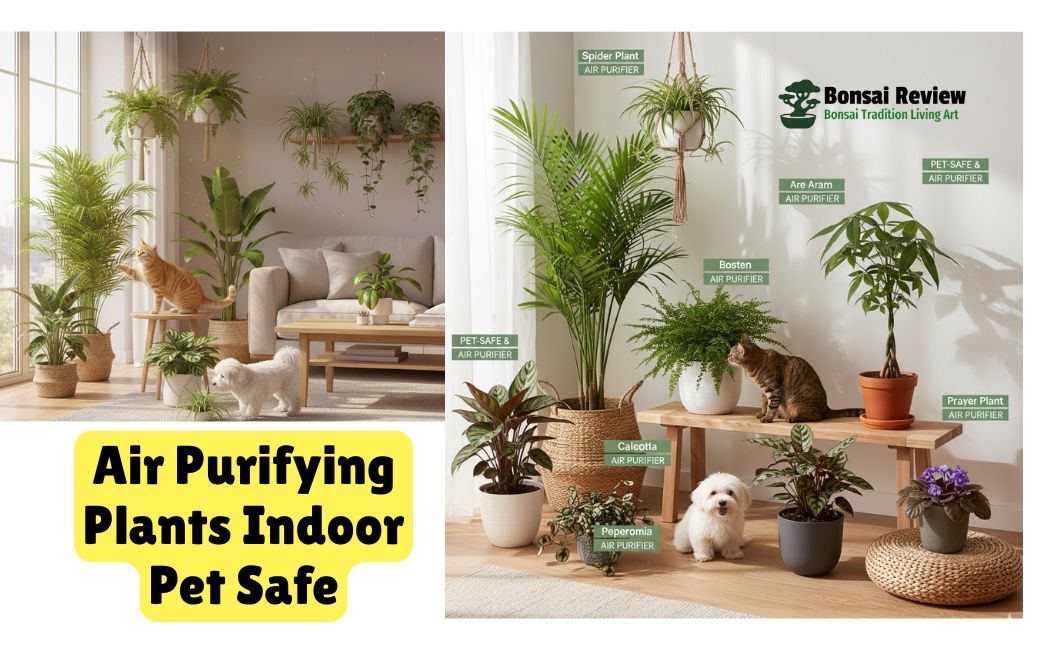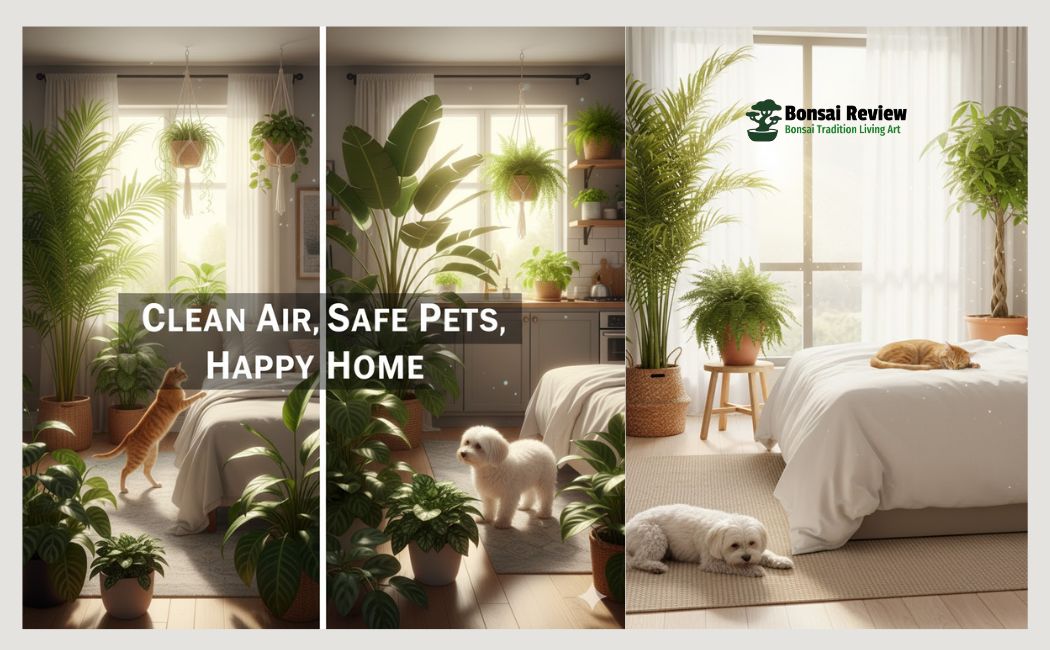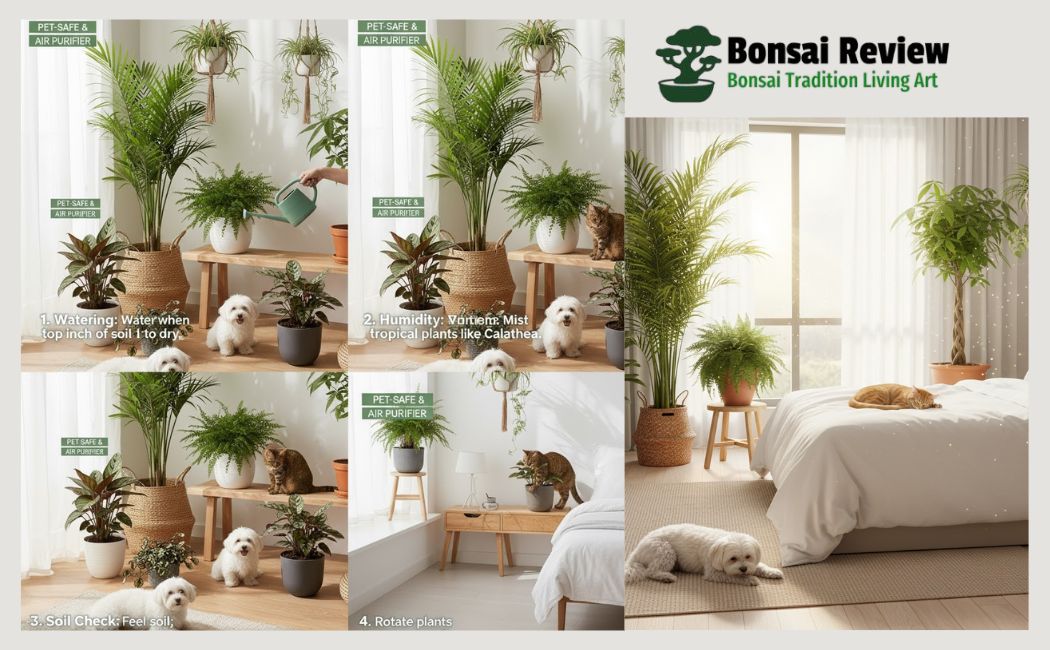Air purifying plants indoor pet safe, what you’ve been looking for, right? Your home air feels heavy, maybe from dust, paint, or cleaning sprays, but you can’t just grab any plant.
You’ve got pets who love to sniff, lick, and chew every green leaf they see. You want cleaner air, but not at the cost of your furry friend’s safety.
NASA’s Clean Air Study proved that some indoor plants naturally remove harmful toxins like formaldehyde, benzene, trichloroethylene, and carbon monoxide from the indoor room air. And even better, many of these plants are marked safe for cats and dogs by ASPCA and PETA.
Plants like Spider Plant (Chlorophytum comosum), Areca Palm (Dypsis lutescens), Boston Fern (Nephrolepis exaltata), and Calathea work like tiny air filters. They take in dirty air and release clean oxygen so you and your pets can breathe fresh air every day.
But not all “air purifiers” are pet-safe. Beautiful ones like Peace Lily (Spathiphyllum), Snake Plant (Dracaena trifasciata), or Aloe Vera can harm pets if chewed. That’s why picking the right plants matters, ones that clean your air and keep your pets happy and safe.
You’ll know exactly which non-toxic indoor plants clear your air, fit in your room’s light, and stay friendly for your cats and dogs. A clean, green, pet-safe home it’s possible, and you’ll see how.
What Air-Purifying Plants are Indoor Pet-Safe? Breathe Fresh & Keep Pets Safe?
Pet-safe, air-purifying indoor plants include the spider plant, areca palm, Boston fern, money tree, Chinese money plant, and various calatheas. Other good options are prayer plants, African violets, and peperomia varieties. Always confirm the specific species is non-toxic, as some related plants can be harmful to pets. Examples of pet-safe air-purifying plants;
- Spider Plant: Known for being non-toxic and effective at removing pollutants like carbon monoxide.
- Areca Palm: A good air purifier that is also safe for cats and dogs.
- Boston Fern: An excellent air-purifying plant that is safe for pets.
- Money Tree: Helps filter out synthetic chemicals and is safe for pets.
- Calathea: A family of plants that includes many safe and air-purifying options.
- Prayer Plant: Filters indoor air pollutants and is a non-toxic choice.
- African Violet: A non-toxic, colorful flowering plant that is also safe for pets.
- Peperomia: A vining plant with heart-shaped leaves that is a good, safe alternative to toxic vining plants like pothos.
Important consideration: Verify that the specific plant for toxicity can vary even within a plant family. Always double-check that the specific species you are buying is non-toxic for your pet before bringing it home.

Why Your Home Needs Air Purifying Plants?
You might think the air inside your home is safe, but it’s not always clean. The truth is, indoor air can be 2 to 5 times more polluted than the air outside, says the EPA (Environmental Protection Agency). Tiny particles float around from your paint, cleaning sprays, furniture, and even your flooring. These release gases called VOCs (Volatile Organic Compounds) like formaldehyde, benzene, and trichloroethylene.
These gases can make you feel tired, dizzy, or give you headaches. Your pets breathe the same air, too, and they’re smaller, so those chemicals can affect them even more.
That’s where air-purifying indoor plants step in. NASA’s Clean Air Study showed that certain houseplants can absorb these toxins through their leaves and roots, turning them into harmless compounds. In return, they release clean, fresh oxygen back into your room.
When you place a few green plants around your living room, kitchen, or bedroom, you create a natural air-cleaning system. These plants not only look calming but also balance moisture, reduce dust, and make your home feel alive again.
So before buying another electric air purifier, try a few natural ones. They cost less, look better, and are safe for your pets when you pick the right kinds.
Why You Must Choose Pet-Safe Plants?
If you have pets, you already know how curious they are. Cats climb, dogs sniff, and both love to nibble on things they shouldn’t. Now imagine bringing home a shiny new plant and your cat takes a bite. You think it’s harmless, but some popular indoor plants can be toxic to pets.
Plants like Peace Lily (Spathiphyllum), Snake Plant (Dracaena trifasciata), Aloe Vera, Pothos (Epipremnum aureum), and English Ivy (Hedera helix) are all known to clean the air, but they can make pets sick if eaten. These plants may cause vomiting, drooling, or stomach pain in cats and dogs.
That’s why choosing pet-safe air purifying plants is so important. You need plants that not only freshen your air but also keep your furry friends safe. The ASPCA (American Society for the Prevention of Cruelty to Animals) and PETA both list which plants are safe or dangerous for pets. Their research helps you know exactly what to pick and what to avoid.
Here’s the happy part of many non-toxic plants still do an amazing job cleaning your air. Choices like Spider Plant (Chlorophytum comosum), Areca Palm (Dypsis lutescens), Boston Fern (Nephrolepis exaltata), and Calathea remove harmful toxins like formaldehyde and benzene while staying safe for both cats and dogs.
When you choose wisely, you get the best of both worlds clean, healthy air and a home where your pets can roam freely without risk.

Best Pet-Safe Air Purifying Indoor Plants
Now that you know why plant safety matters, let’s find the ones that truly help. You don’t need to worry anymore, there are many air purifying plants indoor pet safe for your home. These plants clean your air, look beautiful, and are all approved as non-toxic by the ASPCA.
Each one below was also studied in NASA’s Clean Air Study for its power to remove toxins like formaldehyde, benzene, and trichloroethylene. Here’s your easy list
| Plant Name | Botanical Name | Air Purifying Power | Pet Safety | Light & Care Tips |
| Spider Plant | Chlorophytum comosum | Removes formaldehyde, xylene | Safe for cats & dogs | Bright, indirect light; water weekly |
| Areca Palm | Dypsis lutescens | Removes VOCs, CO₂ | Non-toxic | Likes bright light, moist soil |
| Boston Fern | Nephrolepis exaltata | Filters xylene & formaldehyde | Pet-safe | Loves humidity & indirect light |
| Calathea | Calathea spp. | Filters indoor air | Safe and colorful | Low-light tolerant, mist often |
| Money Tree | Pachira aquatica | Removes chemicals, adds oxygen | Safe for pets | Moderate light, easy to grow |
| Prayer Plant | Maranta leuconeura | Cleans air, boosts oxygen | Non-toxic | Low to medium light |
| Peperomia | Peperomia spp. | Mild air purifier | Safe vine | Easy to care for, loves indirect light |
| African Violet | Saintpaulia | Adds oxygen, beauty | Pet-safe | Thrives in low light, gentle watering |
All these plants are both NASA-tested for air cleaning and ASPCA-verified as safe for pets. Together, they help you build a home that’s fresh, calm, and safe from toxins.
You can mix a few of them, for example, a Spider Plant on your desk, an Areca Palm by your window, and a Boston Fern in your bathroom corner to keep every room balanced and clean.

How to Style and Place Pet-Safe Plants Indoors?
You don’t just want clean air, you want a home that feels peaceful and looks beautiful. The good news? You can do both without risking your pet’s safety.
Start by thinking about where your pets spend most of their time. Dogs love lounging near doors and windows, while cats like climbing to higher spots. That means you’ll want to place your air purifying plants in safe, smart locations away from curious paws or nibbling whiskers. Here’s how you can do it:
1. Living Room Corners: Air Purifying Indoor Plants
Place a large Areca Palm or Money Tree in a stylish pot near your sofa or TV stand. These plants not only remove indoor pollutants but also bring tropical calm to the space.
2. Bathroom or Kitchen: Air Purifying Indoor Plants
The Boston Fern and Spider Plant love humid air. Keep them near your shower window or kitchen shelf; they’ll thrive there while cleaning the air from formaldehyde and carbon monoxide that often build up from soaps or cooking fumes.
3. Bedroom Area: Air Purifying Indoor Plants
Add a Prayer Plant or Calathea beside your nightstand. These plants release oxygen at night, helping you and your pets sleep better and breathe easier.
4. Pet Zones: Air Purifying Indoor Plants
If your pets have their own cozy corner, you can decorate it safely with Peperomia or African Violet. These are compact, non-toxic, and low-maintenance, perfect for smaller spaces.
Pro Tip: Use hanging planters or elevated shelves if your pet likes to chew leaves. You still get the beauty and air benefits, without the risk.
When styled with care, your plants become more than just décor; they become part of your home’s calm, pet-safe ecosystem.
Common Toxic Plants You Should Avoid
Not every air-purifying plant is safe for your pets. Some popular choices can actually make your cats and dogs sick if they chew on the leaves or stems. Knowing which plants are toxic helps you make safe decisions for your home.
Dwarf Plants to Avoid Air Purifying Plants Indoor Pet Safe
- Peace Lily (Spathiphyllum) can cause drooling, vomiting, and stomach pain.
- Snake Plant (Dracaena trifasciata) may trigger nausea or vomiting in cats and dogs.
- Aloe Vera (Aloe barbadensis) is Safe for humans but toxic if eaten by pets.
- Pothos (Epipremnum aureum) Common vining plant, but it can irritate your pet’s mouth and stomach.
- English Ivy (Hedera helix) causes vomiting and diarrhea in pets.
Safe Alternatives: Air-Purifying Plants Indoor Pet Safe.
Don’t worry, you can still enjoy green air-purifying plants. Here are safe swaps:
- Instead of Peace Lily, try Calathea or Prayer Plant.
- Swap Snake Plant for a Spider Plant or Areca Palm.
- Replace Pothos with Peperomia, a safe vining alternative.
Quick Tip: Air-Purifying Plants Indoor Pet Safe
Always double-check the specific species before buying, even within the same plant family. For example, some varieties of Calathea are safe, but closely related species may not be. The ASPCA and PETA lists are reliable references to confirm safety.
By knowing which plants to avoid and which to choose, you can enjoy clean, fresh air while keeping your pets safe and happy.

Care Tips for Low-Maintenance Indoor Living
You’ve picked your air purifying plants indoor pet safe, but now comes the part many people worry about: keeping them alive and healthy. The good news? Most of these plants are low-maintenance and forgiving, even if you’re busy or new to plant care.
1. Light Matters: Air Purifying Plants Indoor Pet Safe
- Bright indirect light is perfect for most plants, like the Spider Plant and Areca Palm.
- Low-light spots work for Calathea, Prayer Plant, and Peperomia.
- Avoid direct sun on sensitive leaves; it can scorch them.
2. Watering Basics: Air Purifying Plants Indoor Pet Safe
- Most pet-safe air-purifying plants like Boston Fern and Calathea like moist soil, but not soggy.
- Check the soil with your finger; if the top inch feels dry, it’s time to water.
- Use filtered or room-temperature water for sensitive plants.
3. Humidity & Air Quality: Air Purifying Plants Indoor Pet Safe.
- Ferns and Calatheas love humidity; mist them occasionally or place them in a bathroom or kitchen.
- Spider Plants and Money Trees are more tolerant of normal indoor humidity.
4. Pot & Soil Tips: Air Purifying Plants Indoor Pet Safe
- Use well-draining pots to prevent root rot.
- Add a layer of pebbles if your pet might dig in the soil.
- Choose elevated or hanging pots for curious cats.
5. Easy Extras: Air Purifying Plants Indoor Pet Safe
- Rotate your plants occasionally so all sides get light.
- Remove dead leaves to keep them looking fresh and prevent pests.
- Grouping a few plants improves air purification and adds natural décor.
With these simple steps, you can enjoy cleaner air, healthier plants, and safe pets all without feeling stressed about plant care.
Bonus: Plants That Boost Oxygen While Safe for Pets
If you want your home to feel even fresher, some pet-safe plants do more than just remove toxins; they also release oxygen, helping you and your pets breathe easier.
Top Oxygen-Boosting, Pet-Safe Plants
- Areca Palm (Dypsis lutescens) Great for large rooms; adds tropical vibes and oxygen.
- Spider Plant (Chlorophytum comosum) Small or medium-sized, perfect for desktops or shelves.
- Money Tree (Pachira aquatica) cleans the air and releases oxygen, plus it’s easy to grow.
- Boston Fern (Nephrolepis exaltata) loves humidity and actively improves air quality in bathrooms or kitchens.
Placement Tips: Air Purifying Plants Indoor Pet Safe.
- Bedrooms: Prayer Plant or Calathea can improve oxygen while you sleep.
- Living rooms: Areca Palm or Money Tree in a corner can refresh large spaces.
- Desks & counters: Spider Plant fits perfectly, keeping your workspace lively and clean.

Why It Matters for Pets?
Oxygen-boosting plants don’t just help you; they support your pets’ health too. Better air circulation can reduce dust and pet allergens, making your home safer for sensitive noses.
By combining air purification and oxygen release, these plants create a natural, safe, and refreshing environment for everyone in your home.
Conclusion: Clean Air, Safe Pets, Happy Home
Choosing air purifying plants indoor pet safe isn’t just about decoration, it’s about creating a healthy, safe, and vibrant home for both you and your pets.
With the right choices, you can remove indoor toxins like formaldehyde, benzene, and VOCs, increase oxygen, and still let your cats and dogs explore freely.
Plants like Spider Plant, Areca Palm, Boston Fern, Calathea, Prayer Plant, Money Tree, Peperomia, and African Violet are ASPCA-approved, low-maintenance, and perfect for almost any room, from bright living areas to low-light bedrooms.
By avoiding toxic plants like Peace Lily, Snake Plant, Pothos, and Aloe Vera, and following simple care tips, you create a safe, stress-free environment.
With the right placement, watering, and lighting, your plants will thrive while keeping your pets safe and your air fresh.
A home filled with pet-friendly, air-purifying plants means you can breathe easier, feel calmer, and enjoy the peace of knowing your furry friends are safe.
Helpful article: Are Bonsai Trees Toxic to Cats? How to Keep Cats and Dogs Both Safe?
FAQs: Air-Purifying Plants Indoor Pet Safe Want Cleaner Air Without Harming Pets? Try These Indoor Plants!
1. What plants purify the air indoors and are safe for pets?
Plants like Spider Plant, Areca Palm, Boston Fern, Calathea, Prayer Plant, Money Tree, Peperomia, and African Violet clean the air naturally and are ASPCA-approved, safe for cats and dogs.
2. Which indoor plant purifies the air the most?
The Spider Plant and Areca Palm are top performers, removing toxins like formaldehyde, benzene, and VOCs, while remaining completely safe for pets.
3. What plant removes 78% of airborne mold naturally?
Boston Ferns are excellent at filtering airborne mold spores and improving indoor air quality, making them a pet-safe choice for bathrooms or kitchens.
4. Which air-purifying plants are safe for cats and dogs?
Always pick non-toxic, low-maintenance plants verified by the ASPCA or PETA, including: Spider Plant, Areca Palm, Calathea, Prayer Plant, Peperomia, Money Tree, etc.
5. Can indoor plants really improve air quality?
Yes! Studies, including NASA’s Clean Air Study, show that air-purifying indoor plants absorb harmful chemicals like formaldehyde, benzene, and trichloroethylene, release fresh oxygen, and can improve humidity. Choosing pet-safe plants ensures both your family and pets enjoy these benefits safely.